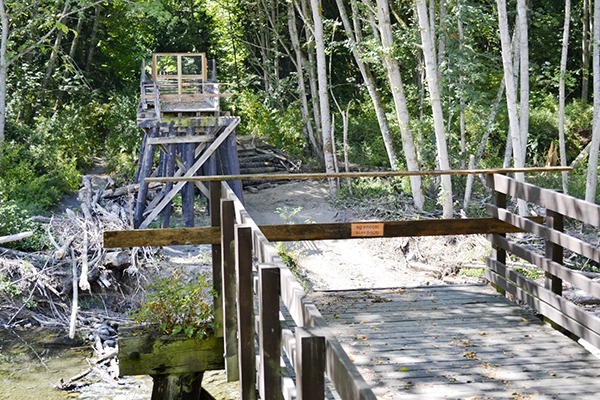A large section of the damaged trestle spanning the Dungeness River at Railroad Bridge Park is no longer there, as the first weekend of August proved an ideal time to begin prepping the 1960s-era trestle for total replacement.
“When funding for the project was guaranteed, the tribe was very anxious to complete the in-river work before any spawning in the project area,” tribe officials said. “The spawning is generally considered to be mid-August but the sooner work could be completed, the better.”
Following the preparatory work, full replacement of the trestle is expected to begin mid-month and ideally end mid-December, Annette Nesse, chief operations officer for Jamestown S’Klallam Tribe, said in a previous interview.
Six months after early February flood conditions resulted in damage to the trestle, which also acts as an integral piece of the Olympic Discovery Trail, the Jamestown S’Klallam Tribe (owners of Railroad Bridge Park, the Howe truss bridge and trestle) have collaborated with a variety of partners to secure funding and identify the best approach to either replace it or temporally repair it.
Together, officials from the engineering firm Otak, an advisory group consisting of representatives of the tribe, the Dungeness River Audubon Center, the River Center Board, the Peninsula Trails Coalition, Washington Department of Fish and Wildlife, the North Olympic Salmon Coalition, the North Olympic Peninsula Lead Entity for Salmon and Clallam County, chose the preferred alternative to completely replace the existing trestle with a modern river, fish and people friendly bridge.
The historical and undamaged 150-foot bridge will remain.
“This option addresses tribal transportation infrastructure goals and provides for river processes, meeting important salmon habitat goals as well,” tribe officials said.
The “complexities associated with modifying a large-scale and environmentally sensitive river crossing connected to a Registered National Historic Property” resulted in months of behind the scenes work and coordination to reach an environmentally and financially viable project, tribe officials said.
Prior to committing to replace the trestle in its entirety, tribe officials needed to secure an estimated $2 million for the project. An approved $1.53 million grant from the Recreation and Conservation Office Salmon Recovery Board coupled with several other funding sources will be used to pursue the project, including tribal insurance proceeds, tribal transportation funding and a contribution from the Peninsula Trails Coalition.
Also, among the many permitting challenges, the Dungeness River is habitat to four species listed as threatened under the federal Endangered Species Act, including Puget Sound chinook, Hood Canal chum, steelhead and bull trout.
A “Determination of Mitigated Significant Impact” was issued following the environmental review process done by the tribe in accordance to the Tribal Environmental Policy Act prior to the preparatory work and removal of the damaged pilings and bents, but to complete the project, the final permits needed under the National Environmental Policy Act and Section 106 reviews are in progress.
Upon replacement, 38 creosote timber pile bent supports will be removed from the riverbed to allow the river to move more naturally. In doing so, the new bridge is projected to create high quality salmon habitat while restoring the bike/pedestrian crossing with a trestle of modern materials that is structurally sound.
“I’m ecstatic!” Powell Jones, Dungeness River Audubon Center executive director, said. “I’m really excited because the design works really well for everyone.”
Since the trestle sustained damages and thus closed to through traffic, the number of visitors to the park has dropped, Jones said, but once the trestle is replaced, he expects the traffic to fully recover.
“It’s going to be amazing,” Jones said. “You rarely get a project like this that’s great for fish, people and the river. It’s usually one or the other.”



